|
Week 4: August 22-28, 2013 |
Welcome
to the McGill Bird Observatory weekly report.
Click here for a complete listing of our archives.
Comments or
questions are welcome at "mbo AT migrationresearch.org".
|
PICTURE
OF THE WEEK: |
|
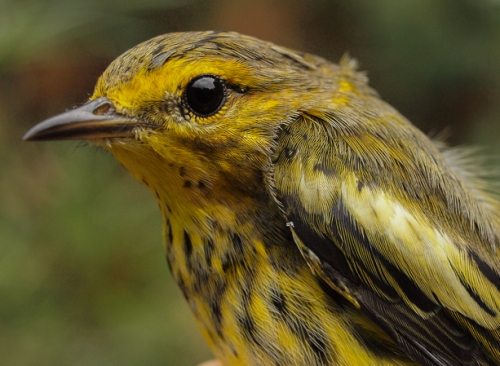
It isn't often that we feature the same species two weeks in a row. However, the 10
Cape May Warblers banded at MBO was that noteworthy - the previous single-week
record was just 6, in the first week of August 2011.
(Photo by Simon Duval)
-
|
|
|
THIS WEEK |
THIS FALL |
2013 TOTAL |
SITE TOTAL |
|
# birds (and species) banded |
330 (40) |
960 (54) |
2255 (83) |
43767 (113) |
|
# birds (and species) repeat |
80 (21) |
258 (31) |
588 (48) |
8569 (70) |
|
# birds (and species) return |
2 (2) |
21 (11) |
176 (31) |
1385 (38) |
|
# species observed |
88 |
115 |
158 |
208 |
|
# net hours |
539.5 |
2149.5 |
5506.3 |
74796.0 |
|
# birds banded / 100 net hours |
61.2 |
44.7 |
41.0 |
58.5 |
|
|
Note: table does not include nocturnal banding (owls) |
|
Banders-in-charge: Simon Duval, Gay Gruner
Assistants: Nicolas Bernier, Sue Bishop, Marie-France Boudreault, Carl Bromwich, Luke Currin, Mark Currin, Rui de Jesus, Jean Demers, Jo-Annie Gagnon, Nathalie Gendron, Alison Hackney, Lisa Keelty, Barbara MacDuff, Betsy McFarlane, Catherine Russell, Ahmad Shah, Clémence Soulard, Patricia Stotland, Elise Titman, Rodger Titman, Carine Touma
IMPORTANT: MBO has been selected as one of five finalists in the Jamieson Vitamins "Call for the Wild" contest for 2013. To support MBO, all you need to do is vote daily between August 19 and September 15 by visiting the contest Facebook page (no login required). Four other organizations are competing for their share of $100,000, and the amount allocated to MBO will be entirely dependent on the number of votes received. Please help us succeed with this important fundraiser by voting for MBO every day!
Notes: What a week! Except for an unusually low total of 128 in 2007, the number of birds banded in week 4 has remained relatively similar over the years, otherwise ranging from 166 to 240. After last week's decidedly average numbers, we certainly were not expecting such a dramatic new week 4 record of 330 individuals! The bulk of the migration (223 of the 330 birds banded) came through over a three day period (Aug 25-27), with between 24 and 31 individuals on each of the four other days this week. The 40 species banded this week was also well above average, although behind the high count of 43 last year. Once again, observations were great throughout the week too, with the 88 species recorded being a big jump from the previous record of 84. Unsurprisingly, the cumulative total of 115 for the season is also still far ahead of any previous year at this time.
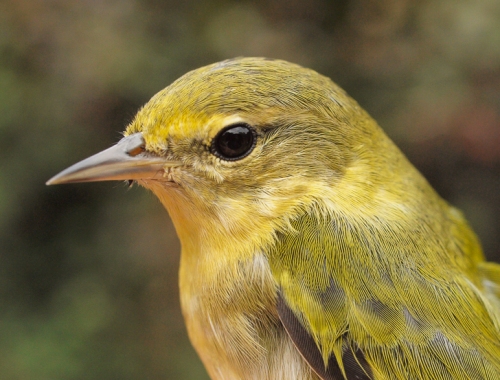
Tennessee Warblers (including the one above) dominated the week, with 73 individuals banded, also a single-week record. The best previously was 52 in week 5 of 2011, so perhaps next week will be even more productive! For comparison, below is a Red-eyed Vireo, occasionally confused with Tennessee Warbler (photos by Simon Duval).

|
Another 8 species this week were seen for the first time this fall, including Common Nighthawk, which was also new for 2013. The other new arrivals for the season were Common Loon, Red-bellied Woodpecker, Broad-winged Hawk, and a quartet of mid-season warblers - Orange-crowned, Blackburnian, Bay-breasted, and Blackpoll. Three of those warblers were also banded for the first time this fall (no luck with Blackburnian yet), as were Blue jay, Golden-crowned Kinglet, and Yellow-rumped Warbler. The Orange-crowned Warbler was the only species not banded earlier this year in spring or summer.
This week’s top 10 [last week's rank in brackets]
# individuals banded |
mean # individuals observed daily |
1. Tennessee Warbler (73) [4] |
1. Cedar Waxwing (40) [1] |
2. Magnolia Warbler (45) [-] |
2. American Goldfinch (39) [2] |
3. Common Yellowthroat (19) [4] |
3. Black-capped Chickadee (24) [3] |
3. American Redstart (19) [1] |
4. American Robin (14) [6] |
5. Northern Waterthrush (17) [-] |
5. American Crow (14) [5] |
5. Song Sparrow (17) [2] |
6. Tennessee Warbler (13) [-] |
7. Yellow-rumped Warbler (13) [-] |
7. Blue Jay (12) [8] |
8. American Goldfinch (12) [-] |
8. Song Sparrow (11) [4] |
9. Ovenbird (10) [-] |
9. Common Grackle (10) [-] |
9. Cape May Warbler (10) [-]
9. Baltimore Oriole (10) [3]
|
10. Magnolia Warbler (9) [-]
|
|
For seven of the previous eight years, Magnolia Warbler has topped the list of species banded in week 4 (the only exception being 2009 when we had only 11 during this week, good for a fifth place tie). They would have easily taken top spot again this year were it not for an unprecedented August wave of Tennessee Warblers. The past two years, we have noticed that the fall flight of Tennessee Warblers has been starting earlier, with 21 of them banded this week in 2012, and 23 in 2011. However, this year, we more than tripled those previous high counts ... a pretty good indication of a spruce budworm outbreak to our north, and a safe bet that we are on our way to a record fall season for Tennessee Warbler and perhaps also a couple of the other spruce budworm specialists (e.g. Cape May and Bay-breasted Warblers). Tied for third place were American Redstarts (beginning to taper off a bit) and Common Yellowthroat (on the increase). The sudden spike of Northern Waterthrushes this week was reminiscent of this week in 2006, when we banded 20 of them. Song Sparrow numbers continue to drop a bit more each week, but with a total of 168 over the first four weeks of the season, they still represent nearly 18% of all birds banded this fall. Perhaps the biggest surprise this week was Yellow-rumped Warbler, with 13 individuals banded - the first time ever we have banded more than two of them in a week in August, and in fact we've never before hit double digits for a week earlier than mid-September. After hanging around in ever-increasing numbers for a few weeks now, American Goldfinches are finally getting banded in decent numbers too, although clearly most of them are still avoiding the nets. Rounding out this week's list is a three-way tie with ten individuals each. We banded the same number of Baltimore Orioles last week, but the drop from third place to ninth reflects the overall increase in migration this week. The count of Cape May Warblers is particularly noteworthy, as only once before have we banded more than 10 individuals in an entire season; as with Tennessee Warblers, we can speculate based on these early numbers that we are in for a new record high count this fall.
The top three species observed this week were unchanged from last week, although goldfinches continue to increase in numbers and are nipping at the heels of the waxwings, which have remained pretty steady throughout August. Robins and crows continue to hang out around the middle of the top ten, and are joined by the first wave of Tennessee Warblers in sixth place, and a slight increase in Blue Jays in seventh. Rounding out the list for the week are Song Sparrow (a drop corresponding to the declining number of individuals banded), and new entries from Common Grackle and Magnolia Warbler, both of which are likely to increase in numbers in the coming weeks.
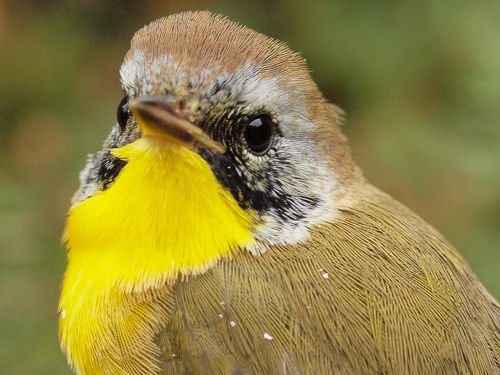
One of the 19 Common Yellowthroats banded at MBO this week.
(Photo by
Simon Duval) |
With 960 birds banded already over the first four weeks of the season, we have a good chance to hit 1000 for August for the first time ever. Combined with the record number of species observed so far this fall, it has been a great start to the season! It's always risky to make predictions, but we expect the flood of warblers to continue for at least another couple of weeks...
|
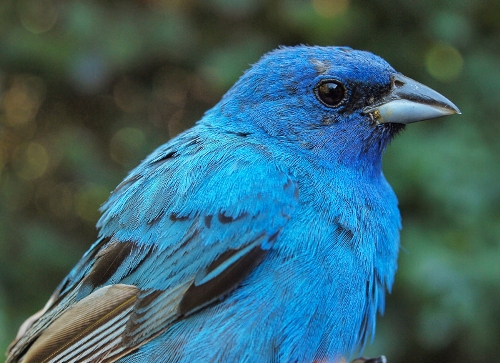
As much as we love the warblers, a bit of variety is always welcome. This adult male was one of 7 Indigo Buntings banded this week, bringing the season total to 18, with the traditional peak of migration yet to come.
(Photo by Simon Duval)
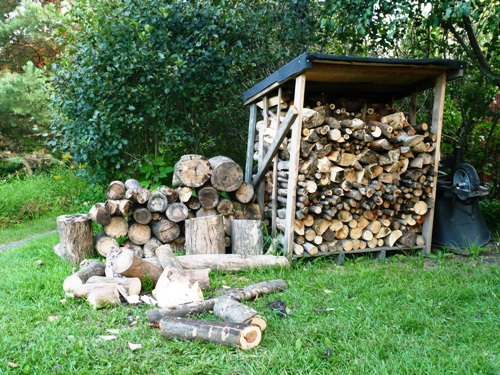
It may be only August, but it's never too early to prepare for the long winter ahead! Thanks to Malcolm Johnson for building a couple of new wood sheds for us, and to various volunteers for spending time chopping and stacking wood.
(Photo by Marcel Gahbauer)
|






